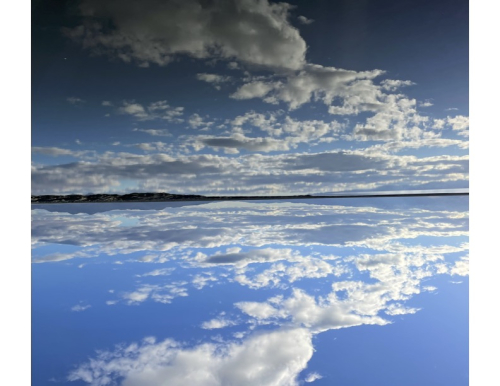May Beauty Gaze into Your Mirror Face
A water cycle by the poets of the Jung Society of Utah on 2/9/24
You brighten my heart with hope for a new day.
I am your daughter. Your soul nourishment, ceaseless.
I am your daughter. Your soul flourishing, ceaseless.
My child body floated in your body.
My child body floated in your body,
a body so much larger than my own.
A body so much larger than my own.
To know you is to constantly be assured.
To know your confidence is to be assured
the world has lived many lives through you.
The world has lived many lives. Through you,
I now understand water to be the sacred source.
I understand now Water, you are the sacred source,
your heart bright with hope for a new day.
What is a Water Cycle?
A water cycle is a formal collective poem with a shape inspired by the poet Jericho Brown’s duplex.
Like the duplex, the water cycle is organized in a series of couplets with repeating lines. The second line of the first couplet becomes the first line of the next. The second line of the second couplet repeats as the first of the third, and so on. ( See examples above.) Variations in repeating lines may exist, but they are intentionally slight. The poem begins and ends with the same line. Unlike the duplex, water cycles are written collectively and thus vary in their number of couplets in order to match the number of writers in any given circle.
Water cycles have emerged from a generative community writing practice called River Writing, especially from groups of River Writers who have devoted their practice to witnessing specific bodies of water. The majority of existing water cycles have been born of folks putting pen to paper along the banks of the Colorado River Basin, the shores of Great Salt Lake, and her tributaries.
Water cycles are created in conversation with water and offered back to the water in the spirit of reverence, relational repair, and reciprocity.
How to Create a Water Cycle:
- Begin with a timed writing session devoted to a specific water body.
- When finished, participants are asked to review their own writing to find a line or phrase they would like to bring forward. The line does not need to be a complete sentence.
- The line will ultimately need to become 9-11 syllables in length. Read several example lines aloud to help writers hear the length of a 9-11 syllable line. Most folks do not habitually count syllables and may feel intimidated, so the facilitator will need to help keep this part playful and light-hearted. Lines can be shortened later.
- Time the phrase-finding activity for 3-5 minutes. Those that finish quickly can be invited to select an alternative phrase as well. However, it is not helpful to have more than two lines per person and one is absolutely enough.
- Participants rewrite the phrase in their notebook. Check syllable count. Shorten if necessary by eliminating a phrase, dropping articles, and/or adjectives.
- The facilitator takes on the role of composer and asks who has a line that could start a conversation? Whoever speaks is offering the first line which the composer records in their own notebook.
- The composer then asks the group: Who has a line that speaks with this one? Could be in agreement, maybe in contrast…The composer continues inviting and recording until every voice in the room is included.
- When the last new line is written, the composer writes the first opening line down after it. The rough draft of the poem in now complete.
- The composer announces the new work and dedicates it to the water. They read it aloud in repeating line form, making sure to end with the first line.
- The composer takes the draft home to polish it with the following guidelines in mind:
- Do not reorder or eliminate any lines.
- You may alter verb tense and pronouns to create coherence.
- Eliminate excess words if needed to unify line length.
- You may choose to play with punctuation, and/or slightly modify some nouns.
- All lines must remain recognizable. Every participant should be able to easily recognize their own voice in the poem.

